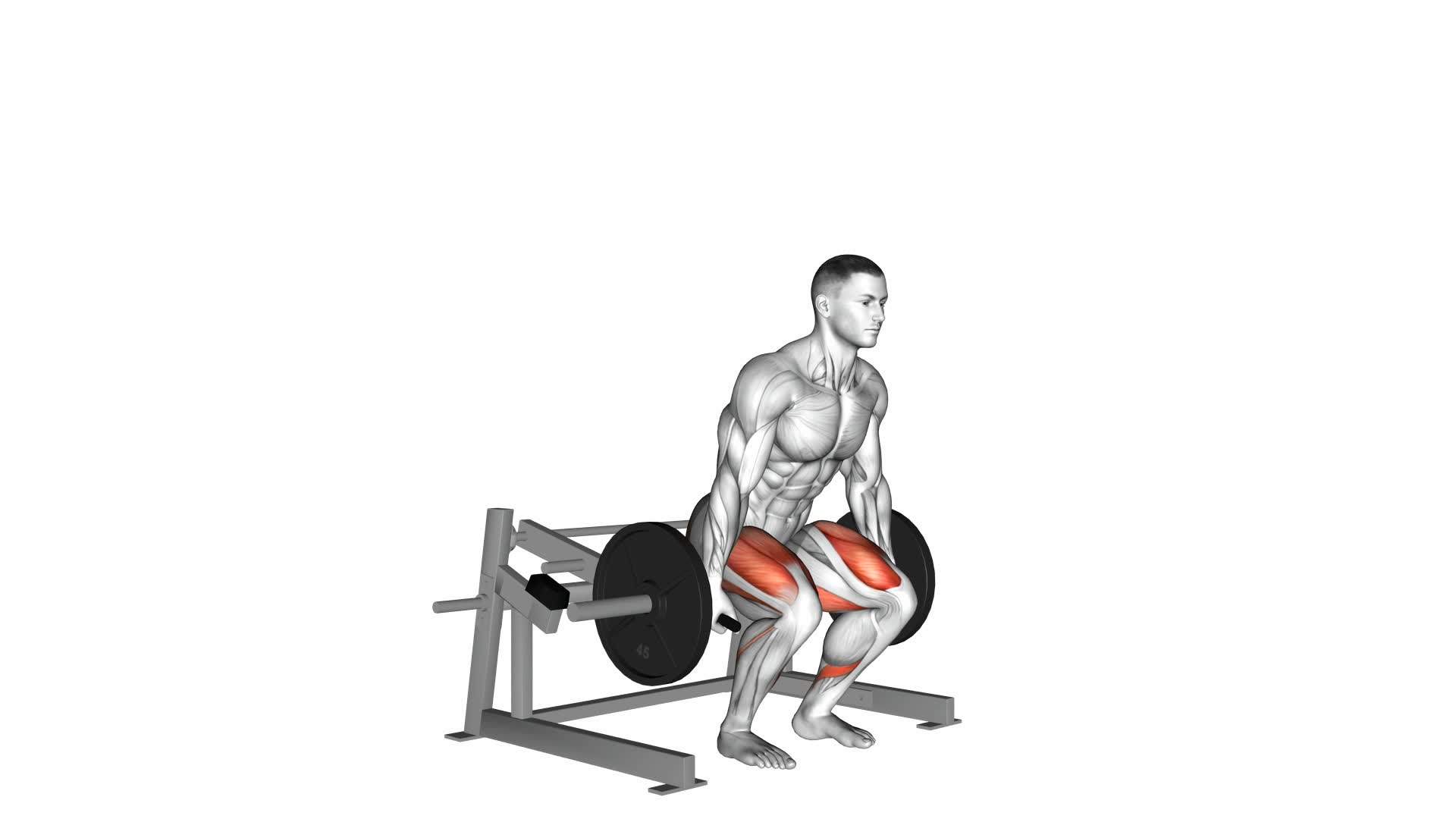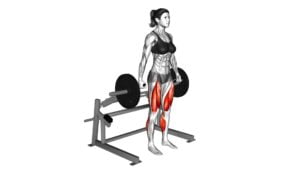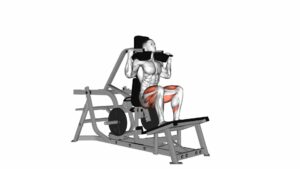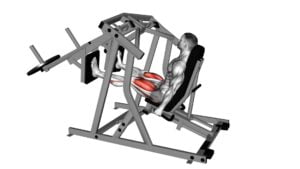Lever Deadlift (Plate Loaded) – Video Exercise Guide & Tips

Looking to maximize your gains with the lever deadlift?
Watch This Exercise Video
This video exercise guide and tips will help you perfect your form and technique for this plate loaded exercise.
Learn about the benefits, common mistakes to avoid, and variations to keep challenging yourself.
With the right equipment and proper execution, you'll be on your way to stronger and more toned muscles.
Watch the video and start lifting with confidence today!
Key Takeaways
- Improved strength in multiple muscle groups, including glutes, hamstrings, quadriceps, and lower back
- Activation of core muscles for improved stability and body control
- Enhanced athletic performance and injury prevention through activation of posterior chain muscles
- Proper form and technique are crucial to target intended muscle groups and reduce the risk of injury
Benefits of the Lever Deadlift
The lever deadlift can provide you with several benefits for your overall strength and muscular development. One of the primary benefits of this exercise is improved strength. By incorporating the lever deadlift into your workout routine, you can target multiple muscle groups, including your glutes, hamstrings, quadriceps, and lower back. This exercise allows you to lift heavier weights, which can lead to increased strength gains over time.
In addition to improved strength, the lever deadlift also promotes muscle activation. When performing this exercise, you engage your core muscles to maintain proper form and stability. This helps to strengthen your core and improve overall body control. Furthermore, the lever deadlift activates your posterior chain, which includes the muscles along the backside of your body, such as your glutes and hamstrings. By targeting these muscles, you can enhance your athletic performance and reduce the risk of injuries.
Proper Form and Technique
To maintain proper form and technique during the lever deadlift, focus on engaging your core and maintaining stability throughout the exercise. This will help you maximize the benefits of the exercise while minimizing the risk of injury.
Here are three key points to keep in mind:
- Keep your back straight: One common error is rounding the back during the lift. This puts excessive strain on the spine and increases the risk of injury. Instead, focus on maintaining a neutral spine throughout the movement.
- Bend your knees and hips: Another common error is using primarily the lower back to lift the weight. To avoid this, initiate the movement by bending your knees and hips, and use the strength of your legs and glutes to drive the lift.
- Engage your glutes and hamstrings: The lever deadlift primarily targets the glutes, hamstrings, and lower back. To effectively engage these muscle groups, focus on squeezing your glutes and hamstrings as you lift the weight.
By following these tips, you can ensure that you're performing the lever deadlift with proper form and technique, effectively targeting the intended muscle groups and reducing the risk of injury.
Now let's move on to the next section, where we'll discuss the equipment needed for the exercise.
Equipment Needed for the Exercise
To perform the lever deadlift, you'll need the following equipment.
- First and foremost, you'll need a lever deadlift machine, which is specifically designed for this exercise. This machine consists of a lever arm and a weight stack, allowing you to adjust the resistance according to your fitness level.
- Additionally, you'll need weight plates that can be loaded onto the lever arm. The weight plates should be appropriate for your strength and goals, and it's recommended to start with lighter weights and gradually increase as you progress.
In terms of safety, it's crucial to have a lifting belt to support your lower back and prevent any potential injuries. This will help maintain proper form and technique throughout the exercise. Along with the lifting belt, it's highly recommended to wear proper workout attire, including comfortable and supportive shoes, to ensure stability and prevent any slips or falls.
To enhance your grip and prevent the weights from slipping, using lifting straps or chalk can be beneficial. These accessories will help you maintain a secure grip on the lever arm throughout the exercise.
Common Mistakes to Avoid
When performing the lever deadlift, it's important to be aware of common mistakes that can hinder your progress and increase your risk of injury. To ensure that you're performing the exercise correctly and safely, here are three common mistakes to avoid:
- Rounding your back: One of the most common mistakes is rounding your back during the lever deadlift. This can put excessive strain on your spine and increase your risk of injury. To avoid this mistake, focus on keeping your back straight and your core engaged throughout the movement.
- Using too much weight: Another common mistake is using too much weight, which can compromise your form and increase the risk of injury. It's important to start with a weight that you can lift with proper technique and gradually increase the weight as you become stronger and more comfortable with the exercise.
- Neglecting proper warm-up: Many people make the mistake of neglecting a proper warm-up before performing the lever deadlift. This can lead to muscle imbalances and increase the risk of injury. Make sure to warm up your muscles with dynamic stretches and perform lighter sets to prepare your body for the exercise.
Variations and Progressions
Continue your lever deadlift journey by exploring variations and progressions that can challenge your strength and enhance your performance.
Progressions are a great way to continuously challenge your body and prevent plateaus in your training.
One popular progression is the single-leg lever deadlift, which increases the demand on your stabilizer muscles and improves balance. To perform this variation, simply lift one leg off the ground and hinge forward at the hips while keeping your back straight.
Another progression is the deficit lever deadlift, where you stand on a platform or step to increase the range of motion and further engage your glutes and hamstrings.
For those looking for modifications, you can try using kettlebells or dumbbells instead of a barbell. This will allow for a greater range of motion and can help develop grip strength.
Additionally, you can experiment with different foot positions, such as a sumo stance or a narrow stance, to target different muscle groups.
Remember to start with lighter weights and gradually increase the intensity as you become more comfortable with the variations and progressions.
Tips for Maximizing Results
To maximize your results, focus on proper form and technique while performing the lever deadlift. Here are some tips to help you get the most out of your workout:
- Maximize intensity: To increase the intensity of your lever deadlift, gradually increase the weight you're lifting. This will challenge your muscles and help you build strength and power. However, make sure to start with a weight that's manageable and allows you to maintain proper form throughout the exercise.
- Use proper recovery strategies: Recovery is crucial for maximizing your results. Make sure to give your body enough time to rest and recover between lever deadlift sessions. This will allow your muscles to repair and grow stronger. Additionally, incorporating strategies such as stretching, foam rolling, and getting enough sleep can also aid in recovery and prevent injury.
- Pay attention to your body: Listen to your body and adjust your lever deadlift routine accordingly. If you're feeling fatigued or experiencing pain, it's important to take a break and give your body the rest it needs. Pushing through pain or overtraining can lead to injury and hinder your progress.
Frequently Asked Questions
How Many Sets and Repetitions Should I Perform When Doing the Lever Deadlift?
When performing the lever deadlift, it's important to consider the number of sets and repetitions that are suitable for your fitness level and goals.
The lever deadlift is a versatile exercise with various variations, each offering their own benefits.
To determine the appropriate sets and repetitions, consult with a fitness professional or trainer who can assess your abilities and create a personalized workout plan.
This will ensure that you're performing the lever deadlift in a safe and effective manner.
Can the Lever Deadlift Be Modified for Individuals With Lower Back Pain?
To manage lower back pain, you may need to modify the lever deadlift exercise. There are a few ways to do this.
First, you can decrease the weight you're lifting to reduce strain on your back.
Second, try using a wider stance and bending your knees more to engage your leg muscles instead of relying solely on your back.
Lastly, consider using a lifting belt for added support.
Always consult with a professional before making any modifications.
Is It Necessary to Use a Belt or Straps When Performing the Lever Deadlift?
When performing the lever deadlift, you might wonder if it's necessary to use a belt or straps. Using a belt can provide support and stability to your lower back, reducing the risk of injury. It helps to maintain proper form and allows you to lift heavier weights.
On the other hand, straps can improve your grip strength, allowing you to hold onto the barbell more securely. Both the belt and straps have their benefits, so it's up to you to decide which one to use.
Can the Lever Deadlift Be Done Without a Spotter or Partner?
Yes, you can do the lever deadlift without a spotter or partner. It's a safe exercise that can be performed independently. You don't need a belt or straps either. In fact, you can even do lever deadlifts with dumbbells or resistance bands if you prefer.
Just make sure to maintain proper form and start with a weight that you can handle comfortably. Remember to engage your core and keep your back straight throughout the movement.
Are There Any Specific Warm-Up Exercises That Should Be Done Before Attempting the Lever Deadlift?
Before attempting the lever deadlift, it's important to warm up properly. Start with specific warm-up exercises like bodyweight squats, lunges, and hip hinges to activate your lower body muscles. These movements will increase blood flow, improve flexibility, and reduce the risk of injury.
If you have lower back pain, consider modifying the lever deadlift by using lighter weights or focusing on other exercises that target the same muscle groups. Always listen to your body and stop if you feel any discomfort.
Conclusion
In conclusion, the lever deadlift is a highly effective exercise for building strength and targeting multiple muscle groups. By using proper form and technique, along with the necessary equipment, you can minimize the risk of injury and maximize your results.
Avoiding common mistakes and progressing with variations will help you continuously challenge your muscles. Remember to apply these tips to get the most out of your lever deadlift workouts.

Author
Years ago, the spark of my life’s passion ignited in my mind the moment I stepped into the local gym for the first time. The inaugural bead of perspiration, the initial endeavor, the very first surge of endorphins, and a sense of pride that washed over me post-workout marked the beginning of my deep-seated interest in strength sports, fitness, and sports nutrition. This very curiosity blossomed rapidly into a profound fascination, propelling me to earn a Master’s degree in Physical Education from the Academy of Physical Education in Krakow, followed by a Sports Manager diploma from the Jagiellonian University. My journey of growth led me to gain more specialized qualifications, such as being a certified personal trainer with a focus on sports dietetics, a lifeguard, and an instructor for wellness and corrective gymnastics. Theoretical knowledge paired seamlessly with practical experience, reinforcing my belief that the transformation of individuals under my guidance was also a reflection of my personal growth. This belief holds true even today. Each day, I strive to push the boundaries and explore new realms. These realms gently elevate me to greater heights. The unique combination of passion for my field and the continuous quest for growth fuels my drive to break new ground.







